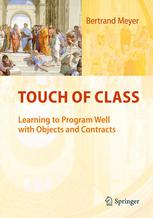

Most ebook files are in PDF format, so you can easily read them using various software such as Foxit Reader or directly on the Google Chrome browser.
Some ebook files are released by publishers in other formats such as .awz, .mobi, .epub, .fb2, etc. You may need to install specific software to read these formats on mobile/PC, such as Calibre.
Please read the tutorial at this link: https://ebookbell.com/faq
We offer FREE conversion to the popular formats you request; however, this may take some time. Therefore, right after payment, please email us, and we will try to provide the service as quickly as possible.
For some exceptional file formats or broken links (if any), please refrain from opening any disputes. Instead, email us first, and we will try to assist within a maximum of 6 hours.
EbookBell Team

4.4
32 reviewsFrom object technology pioneer, Design by Contract inventor and ETH Zurich professor Bertrand Meyer, winner of ACM Software System Award, the Dahl-Nygaard prize and the Jolt award, Touch of Class is a revolutionary introductory programming textbook that makes learning programming fun and rewarding.
Instead of the traditional low-level examples, Meyer builds his presentation on a rich object-oriented software system supporting graphics and multimedia, which students can use to produce impressive applications from day one, then explore "from the outside in" as they learn new programming techniques.
Unique to Touch of Class is the combination of a practical, hands-on approach with sound theory. Throughout the presentation of software concepts, the book relies on the principles of Design by Contract, critical to software quality and providing a gentle introduction to formal methods.
The coverage is notable in both its depth and its breadth. In addition to core programming concepts such as control structures, algorithms and fundamental data structures, it encompasses recursion (including theory and implementation), reference and pointer manipulation, inheritance and associated techniques of polymorphism and dynamic binding, topological sort as an example of algorithm and API design, syntax description techniques, important design patterns such as Observer and Visitor, event-driven programming, high-level function closures (including an introduction to lambda calculus) and software tools. The final chapter is a detailed introduction to the challenges and techniques of software engineering, from lifecycle models to requirements analysis.
The use of full color brings exciting programming concepts to life.
Touch of Class gives students the leading edge by teaching both the fundamental techniques of programming and the professional-level skills preparing them for the challenges of modern software engineering.